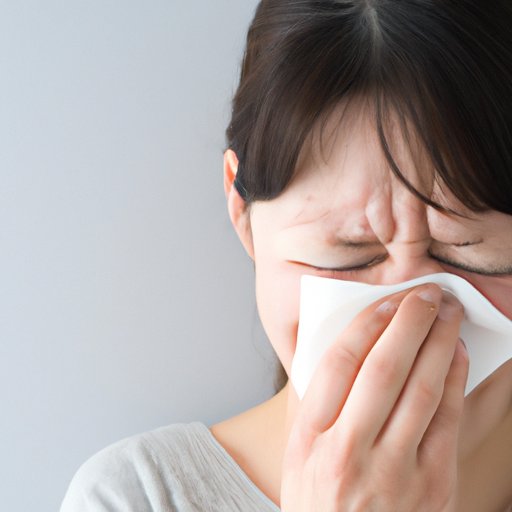Introduction
Crying is often associated with feelings of sadness and vulnerability, but contrary to popular belief, it can be beneficial to our physical and mental health. Studies have shown that shedding tears can provide relief from stress and trauma, as well as help us process and manage difficult emotions. In this article, we will explore the science behind the health benefits of tears and the role of crying in improving physical and mental well-being.
Examining the Benefits of Crying: Is it Healthy?
When it comes to understanding the health benefits of crying, it’s important to consider both the physical and mental effects. Let’s take a closer look at the evidence supporting the notion that crying is healthy.
Physical Health Benefits
Studies have found that crying can reduce levels of cortisol, the body’s primary stress hormone. According to a 2018 study published in the journal Psychoneuroendocrinology, crying is associated with a decrease in cortisol levels, which can lead to improved physical health. The study also found that crying is associated with improved immune system functioning, lower blood pressure, and reduced symptoms of depression and anxiety.
Mental Health Benefits
In addition to its physical health benefits, crying can also improve mental well-being. A 2020 study published in the journal Clinical Psychological Science found that crying can reduce negative emotions such as anger, guilt, and shame. The study also found that crying can increase feelings of optimism and self-compassion, which can lead to improved mental health.

Exploring the Science Behind the Health Benefits of Tears
Now that we’ve established the potential health benefits of crying, let’s take a look at the science behind tears and how they affect our bodies.
How Tears Work
Tears are composed of three layers: an outer layer, a middle layer, and an inner layer. The outer layer consists of water, proteins, and lipids, while the middle layer contains electrolytes and other chemicals. The inner layer consists of hormones, enzymes, and antimicrobial substances. Each layer serves a unique purpose, from lubricating the eye to protecting against infection.
Types of Tears and Their Effects
There are three types of tears: basal, reflex, and emotional. Basal tears are produced continuously to keep the eyes moist and lubricated. Reflex tears are produced in response to irritation or injury, while emotional tears are produced in response to strong emotions such as joy or sadness. Each type of tear has its own chemical composition and physiological effects.
Understanding How Healthy Crying Can Improve Mental Well-Being
Now that we’ve explored the science behind tears, let’s take a look at how healthy crying can improve mental well-being.
Positive Emotional Outcomes
A 2019 study published in the journal Emotion found that crying can lead to positive emotional outcomes such as increased feelings of hope and optimism. The study also found that crying can reduce feelings of distress and rumination, which can improve mental health.
Improved Stress Management
Crying can also help manage stress by releasing endorphins, which are hormones that act as natural painkillers. Endorphins can help reduce stress levels and improve mood. Additionally, crying can help reduce the body’s production of the stress hormone cortisol, which can lead to improved stress management.
What Happens Physically When You Cry?
Let’s take a look at what happens physically when you cry.
Physiological Reactions
When you cry, your body releases hormones and neurotransmitters such as oxytocin, prolactin, and serotonin. These hormones and neurotransmitters can trigger a variety of physiological reactions, such as increased heart rate and respiration, increased tear production, and increased muscle tension.
Brain Activity During Crying
Research has also found that crying can affect brain activity. A 2017 study published in the journal Neuroscience & Biobehavioral Reviews found that crying activates the brain’s reward centers, which can lead to improved mood and emotional regulation. The study also found that crying can activate the brain’s fear pathways, which can lead to increased stress levels.
Uncovering the Psychological and Emotional Benefits of Shedding Tears
Now that we’ve explored the physical effects of crying, let’s take a look at the psychological and emotional benefits.
Relief from Emotional Overload
Crying can provide relief from emotional overload by helping us process and release difficult emotions. According to a 2014 study published in the journal Clinical Psychology Review, crying can help people regulate their emotions and cope with difficult situations. The study found that crying can help people gain insight into their feelings and provide a sense of control over their emotions.
Grief Relief
Crying can also provide relief from grief and loss. A 2015 study published in the journal Death Studies found that crying can help people cope with bereavement and adjust to life after a loss. The study found that crying can help people process their emotions and find meaning in their experiences.

Investigating the Role of Crying in Coping With Stress and Trauma
Finally, let’s take a look at how crying can help us cope with stress and trauma.
Crying as a Form of Self-Regulation
Crying can be used as a form of self-regulation to help manage stress and traumatic experiences. A 2018 study published in the journal Frontiers in Psychology found that crying can help people regulate their emotions and reduce the intensity of their distress. The study also found that crying can help people gain insight into their experiences and gain a greater understanding of their emotions.
Crying as a Tool for Healing
Crying can also be used as a tool for healing. A 2016 study published in the journal Qualitative Health Research found that crying can help people cope with traumatic experiences and foster resilience. The study found that crying can help people process their emotions and gain a sense of control over their experiences.
Conclusion
In conclusion, crying can provide many physical and mental health benefits. Studies have found that crying can reduce levels of cortisol, the body’s primary stress hormone, and improve immune system functioning. Crying can also lead to positive emotional outcomes, improved stress management, and relief from emotional overload and grief. Finally, crying can be used as a form of self-regulation and a tool for healing.
Overall, crying can be beneficial to our physical and mental health. While it may not always be comfortable or easy, allowing yourself to shed tears can have profound benefits for your overall well-being.
(Note: Is this article not meeting your expectations? Do you have knowledge or insights to share? Unlock new opportunities and expand your reach by joining our authors team. Click Registration to join us and share your expertise with our readers.)
